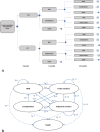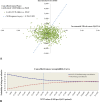Cost-Effectiveness and Clinical Outcomes of Lateral Lumbar Interbody Fusion With Tricalcium Phosphate and Iliac Bone Graft Compared With Posterior Lumbar Interbody Fusion With Local Bone Graft in Single-Level Lumbar Spinal Fusion Surgery in Thailand
- PMID: 38886013
- PMCID: PMC11616388
- DOI: 10.14444/8615
Cost-Effectiveness and Clinical Outcomes of Lateral Lumbar Interbody Fusion With Tricalcium Phosphate and Iliac Bone Graft Compared With Posterior Lumbar Interbody Fusion With Local Bone Graft in Single-Level Lumbar Spinal Fusion Surgery in Thailand
Abstract
Background: Nowadays, minimally invasive lateral lumbar interbody fusion (LLIF) is used to treat degenerative lumbar spine disease. Many studies have proven that LLIF results in less soft tissue destruction and rapid recovery compared with open posterior lumbar interbody fusion (PLIF). Our recent cost-utility study demonstrated that LLIF was not cost-effective according to the Thai willingness-to-pay threshold, primarily due to the utilization of an expensive bone substitute: bone morphogenetic protein 2. Therefore, this study was designed to use less expensive tricalcium phosphate combined with iliac bone graft (TCP + IBG) as a bone substitute and compare cost-utility analysis and clinical outcomes of PLIF in Thailand.
Methods: All clinical and radiographic outcomes of patients who underwent single-level LLIF using TCP + IBG and PLIF were retrospectively collected. Preoperative and 2-year follow-up quality of life from EuroQol-5 Dimensions-5 Levels and health care cost were reviewed. A cost-utility analysis was conducted using a Markov model with a lifetime horizon and a societal perspective.
Results: All enrolled patients were categorized into an LLIF group (n = 30) and a PLIF group (n = 50). All radiographic results (lumbar lordosis, foraminal height, and disc height) were improved at 2 years of follow-up in both groups (P < 0.001); however, the LLIF group had a dramatic significant improvement in all radiographic parameters compared with the PLIF group (P < 0.05). The fusion rate for LLIF (83.3%) and PLIF (84%) was similar and had no statistical significance. All health-related quality of life (Oswestry Disability Index, utility, and EuroQol Visual Analog Scale) significantly improved compared with preoperative scores (P < 0.001), but there were no significant differences between the LLIF and PLIF groups (P > 0.05). The total lifetime cost of LLIF was less than that of PLIF (15,355 vs 16,500 USD). Compared with PLIF, LLIF was cost-effective according to the Thai willingness-to-pay threshold, with a net monetary benefit of 539.76 USD.
Conclusion: LLIF with TCP + IBG demonstrated excellent radiographic and comparable clinical health-related outcomes compared with PLIF. In economic evaluation, the total lifetime cost was lower in LLIF with TCP + IBG than in PLIF. Furthermore, LLIF with TCP + IBG was cost-effective compared with PLIF according to the context of Thailand.
Clinical relevance: LLIF with less expensive TCP + IBG as bone graft results in better clinical and radiographic outcomes, less lifetime cost, and cost-effectiveness compared with PLIF. This suggests that LLIF with TCP + IBG could be utilized in lower- and middle-income countries for treating patients with degenerative disc disease.
Keywords: cost-utility analysis; lateral lumbar interbody fusion (LLIF); posterior lumbar interbody fusion (PLIF); quality-adjusted life-year (QALY); tricalcium phosphate (TCP).
This manuscript is generously published free of charge by ISASS, the International Society for the Advancement of Spine Surgery. Copyright © 2024 ISASS. To see more or order reprints or permissions, see http://ijssurgery.com.
Conflict of interest statement
Declaration of Conflicting Interests : The authors report no conflicts of interest in this work.
Figures



Similar articles
-
Lateral lumbar interbody fusion (LLIF) reduces total lifetime cost compared with posterior lumbar interbody fusion (PLIF) for single-level lumbar spinal fusion surgery: a cost-utility analysis in Thailand.J Orthop Surg Res. 2023 Feb 16;18(1):115. doi: 10.1186/s13018-023-03588-w. J Orthop Surg Res. 2023. PMID: 36797750 Free PMC article.
-
An effectiveness and economic analyses of tricalcium phosphate combined with iliac bone graft versus RhBMP-2 in single-level XLIF surgery in Thailand.BMC Musculoskelet Disord. 2023 Jun 19;24(1):503. doi: 10.1186/s12891-023-06590-9. BMC Musculoskelet Disord. 2023. PMID: 37337174 Free PMC article.
-
Comparison of Minimally Invasive Lateral Lumbar Interbody Fusion, Minimally Invasive Lateral Lumbar Interbody Fusion, and Open Posterior Lumbar Interbody Fusion in the Treatment of Single-Level Spondylolisthesis of L4-L5.World Neurosurg. 2022 Feb;158:e10-e18. doi: 10.1016/j.wneu.2021.10.064. Epub 2021 Oct 9. World Neurosurg. 2022. PMID: 34637941
-
Lateral Lumbar Interbody Fusion (Direct Lateral Interbody Fusion/Extreme Lateral Interbody Fusion) versus Posterior Lumbar Interbody Fusion Surgery in Spinal Degenerative Disease: A Systematic Review.World Neurosurg. 2023 Mar;171:10-18. doi: 10.1016/j.wneu.2022.12.033. Epub 2022 Dec 12. World Neurosurg. 2023. PMID: 36521760
-
Lumbar interbody fusion: techniques, indications and comparison of interbody fusion options including PLIF, TLIF, MI-TLIF, OLIF/ATP, LLIF and ALIF.J Spine Surg. 2015 Dec;1(1):2-18. doi: 10.3978/j.issn.2414-469X.2015.10.05. J Spine Surg. 2015. PMID: 27683674 Free PMC article. Review.
References
-
- Weinstein JN, Lurie JD, Tosteson TD, et al. . Surgical compared with nonoperative treatment for lumbar degenerative spondylolisthesis. four-year results in the spine patient outcomes research trial (SPORT) randomized and observational cohorts. J Bone Joint Surg Am. 2009;91(6):1295–1304. 10.2106/JBJS.H.00913 - DOI - PMC - PubMed
-
- Lucio JC, Vanconia RB, Deluzio KJ, Lehmen JA, Rodgers JA, Rodgers W. Economics of less invasive spinal surgery: an analysis of hospital cost differences between open and minimally invasive Instrumented spinal fusion procedures during the perioperative period. Risk Manag Healthc Policy. 2012;5:65–74. 10.2147/RMHP.S30974 - DOI - PMC - PubMed
-
- Boonsirikamchai W, Phisalpapra P, Kositamongkol C, Korwutthikulrangsri E, Ruangchainikom M, Sutipornpalangkul W. Lateral lumbar Interbody fusion (LLIF) reduces total lifetime cost compared with posterior lumbar interbody fusion (PLIF) for single-level lumbar spinal fusion surgery: a cost-utility analysis in Thailand. J Orthop Surg Res. 2023;18(1):115. 10.1186/s13018-023-03588-w - DOI - PMC - PubMed
LinkOut - more resources
Full Text Sources
